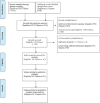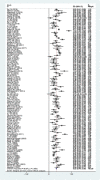Prevalence and influencing factors of nonunion in patients with tibial fracture: systematic review and meta-analysis
- PMID: 32883313
- PMCID: PMC7469357
- DOI: 10.1186/s13018-020-01904-2
Prevalence and influencing factors of nonunion in patients with tibial fracture: systematic review and meta-analysis
Abstract
Objective: The aim of this study is to assess the prevalence of nonunion in patients with tibia fracture and the association between influencing factors and tibia fracture nonunion.
Method: A database searches of PubMed, the Cochrane Library, EMBASE, China National Knowledge Infrastructure (CNKI), Weipu database, and Wanfang database from inception until June 2019 was conducted. The pooled prevalence, odds ratio (OR), and 95% confidence intervals (CI) were calculated with Stata software.
Results: In this study, 111 studies involving 41,429 subjects were included. In the study of the relationship between influencing factors and tibia fracture nonunion, 15 factors significantly influenced the fracture union, including > 60 years old, male, tobacco smoker, body mass index > 40, diabetes, nonsteroidal anti-inflammatory drugs (NSAIDs) user, opioids user, fracture of middle and distal tibia, high-energy fracture, open fracture, Gustilo-Anderson grade IIIB or IIIC, Müller AO Classification of Fractures C, open reduction, fixation model, and infection.
Conclusion: The prevalence of nonunion in patients with tibia fracture was 0.068 and 15 potential factors were associated with the prevalence. Closed reduction and minimally invasive percutaneous plate osteosynthesis (MIPPO) have the low risks of nonunion for the treatment of tibial fractures.
Keywords: Influencing factors; Nonunion; Prevalence; Systematic review; Tibia fracture.
Conflict of interest statement
The authors declare that they have no competing interests.
Figures
References
-
- Bell A, Templeman D, Weinlein JC. Nonunion of the Femur andTibia: An Update. Orthop Clin North Am. 2016;47(2):365–375. - PubMed
-
- Zura R, Braid-Forbes MJ, Jeray K, et al. Bone fracture nonunion ratedecreases with increasing age: A prospective inception cohort study. Bone. 2017;95:26–32. - PubMed
-
- Zura R, Watson JT, Einhorn T, et al. An inception cohort analysis topredict nonunion in tibia and 17 other fracture locations. Injury. 2017;48(6):1194–1203. - PubMed
-
- Lerner RK, Esterhai JL, Jr, Polomano RC, et al. Quality of lifeassessment of patients with posttraumatic fracture nonunion, chronic refractory osteomyelitis, and lower-extremity amputation. Clin Orthop Relat Res. 1993;295:28–36. - PubMed
Publication types
MeSH terms
Substances
LinkOut - more resources
Full Text Sources
Medical





